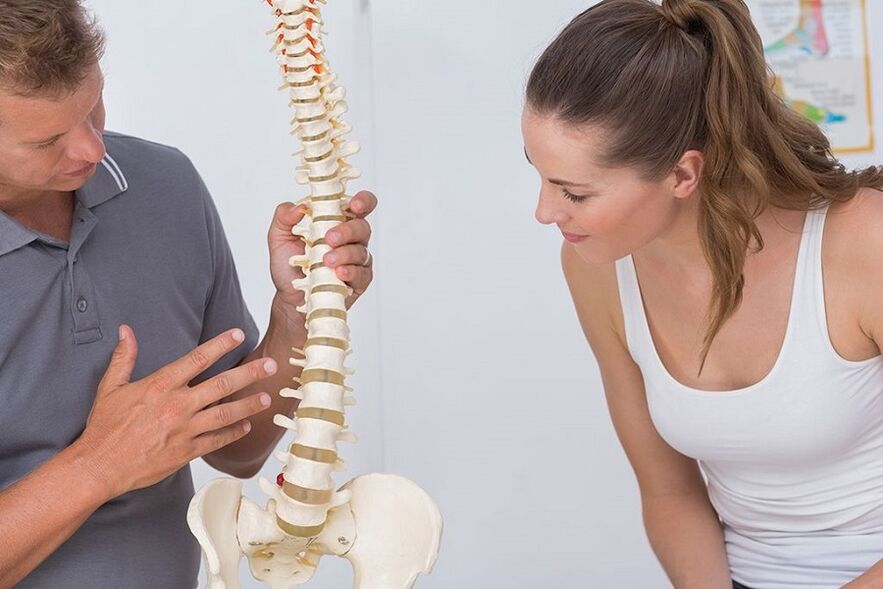According to medical statistics, osteochondrosis of the cervical spine is a relatively common disease in recent years. Everyone at least once in their lifetime experiences unpleasant symptoms.

The disease itself is damage to the intervertebral disc of the cervical spine. However, it is in this part of the human spine that the maximum continuous load occurs.
The cervical region consists of 7 discs. Because of his weak muscles and the constant load on them, various injuries and disruptions in work can occur. Due to all these factors, cervical osteochondrosis begins to develop.
Type of disease
Osteochondrosis is a dangerous disease that may not manifest itself in the long run. There are several stages in the development of this disease:
- stage 1 cervical osteochondrosis (indicated by early spinal disorders);
- grade 2 cervical osteochondrosis (the distance between the discs of the cervical spine begins to decrease);
- grade 3 cervical osteochondrosis (complete destruction of the intervertebral disc ring occurs and severe deformation of the entire spine begins);
- stage 4 cervical osteochondrosis (the final stage of development of the disease, which can lead to deformity).
Causes of onset and progression of the disease
Like other diseases, cervical osteochondrosis has its own causes and developmental factors. Until a few decades ago, only the elderly were susceptible to the disease. Also, osteochondrosis of the neck strikes men after the age of 40 who do heavy physical work.
Currently, osteochondrosis of the neck is becoming increasingly common, affecting young people over 20 years of age. There are many reasons for the development of diseases of the cervical and thoracic spine:
- existing overweight;
- incorrect posture and, consequently, curvature of the spine of 1 or 2 degrees;
- hard physical labor or professional sports, as various spinal injuries are received;
- the causes of severe stress and emotional distress;
- weak muscles in the cervixothorax region;
- sudden cessation of sports after prolonged training;
- work related to sitting at a computer or being in one position for a long time.
If you find yourself with the reasons listed, then you fall into the risk group mentioned. In this case, it is necessary to prevent osteochondrosis of the cervical spine.

Manifestations of the disease
With 1st degree osteochondrosis, a person practically does not feel the symptoms of the developing disease. Only the beginning of pinching the neck muscles begins.
Grade 2 cervical spine osteochondrosis usually manifests itself as minor pain that can occur in the cervical and thoracic segments. This occurs due to pinching of the nerve endings due to a decrease in the distance between the spinal discs.
Grades 3 and 4 of the disease go unnoticed. In this case, the spinal deformity can be seen with the naked eye, not to mention the sensations a person experiences.
The main and more common symptoms of this disease include:
- severe persistent headache;
- ringing in the head;
- impaired movement and coordination;
- deterioration of vision and dental health;
- cerebrovascular accidents, insomnia and various neurological problems.
At 1, 2, 3 or 4 degrees of the disease, the pain can spread to the shoulder and arm joint areas. The characteristic feature of this symptom, which distinguishes it from other diseases, is that the discomfort changes its strength and concentration depending on the position of the neck and dizziness.
Disease syndrome
All the symptoms that appear in osteochondrosis can be proven incorrectly and, as a result, a misdiagnosis is possible. That is why, with the existing symptoms, it is necessary to know all the reasons for its appearance. Thus, medicine knows several syndromes that distinguish between their original causes:
Radicular syndrome
In this case, the nerve is pinched and the person feels pain and numbness in one part of the neck. Unpleasant sensations can spread to the back, to the scapular area, and even to the arms;
Improper reflex syndrome
Manifested by severe and unbearable pain in the back of the head, which spreads throughout the neck. Often it occurs with sharp movements or rotation of the head;
Vertebral artery syndrome
In this case, its name is distinctive. There is a pinch of the artery and the person feels a severe throbbing headache, which can result in loss of consciousness or vomiting;
Heart syndrome
Manifested by increased heart rate, dizziness and loss of consciousness. Often, in these cases, a misdiagnosis is made and treatment of angina pectoris begins.

Treatment
With osteochondrosis, a person is always given immediate treatment. The tactics chosen depend on the stage of the disease. So, at 1 or 2 degrees, full recovery is possible after therapy. At a later stage, medical correction is usually aimed at preventing complications as well as improving quality of life.
First aid
What to do when the first symptoms of the disease occur? First, you need to relieve pain from the cervical area. To do this, you need to do regular analgesics, lie down or rest.
The next step is to see a doctor to get an accurate diagnosis and treatment.
Conservative treatment
With confirmed osteochondrosis, conservative treatment is usually prescribed. Patients are indicated to take anti-inflammatory drugs, analgesics. You can use a variety of gels or ointments to relieve swelling and inflammation. Also, the doctor can prescribe massage, therapeutic exercises. Physiotherapy for osteochondrosis of the cervical spine is prescribed in almost all cases.
Surgery
In rare cases, with highly advanced osteochondrosis, it is possible to perform surgery. In this case, the patient is put into a state of sleep with the help of general anesthesia, after which removal of the bone formation between the discs of the cervical spine is performed. After manipulation, patients are shown conservative treatment or physiotherapy.
Preventive measures
Because of the declining age of cervical osteochondrosis, everyone needs to do its prevention. This is especially true for those at risk.
Important rules
Prevention of cervical osteochondrosis consists of following simple but very important rules:
- watch your posture, do not let it bend;
- do not expose the spine to heavy loads;
- you cannot make sudden head movements;
- do not tremble, avoid stress;
- don't get the flu, don't get too cold;
- get rid of bad habits, switch to proper nutrition.
Special training
To protect yourself from such diseases, you need to do preventive exercises:
- place the palms to your forehead, tighten your neck muscles, then move your hands to the back of your head and repeat the exercise, you need to do it for 7 seconds in 3 sets;
- place the palms to your temples, then tighten your neck muscles, repeat the same action on the other side, time, the amount of approach is the same as in the first paragraph;
- lift the head back, then slowly extend the chin to the chest, you need to do the exercise 3 times;
- turn the head in different directions - you need to do this exercise slowly, without sudden movements;
- tilt your head back, touch one shoulder with your ear, then the other, repeat the exercise 5 times.
If there are one or more symptoms of the disease, call your doctor immediately. Maybe you will just be given physiotherapy treatment and this will be the end. Do not procrastinate, do not start the disease.
Do your daily exercise. It is better to do basic exercises than to suffer from illness later on.
Ask your doctor how to sleep to get cervical osteochondrosis. Follow all the rules, be healthy!

















































